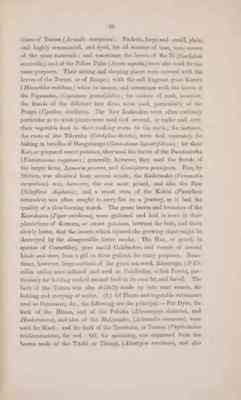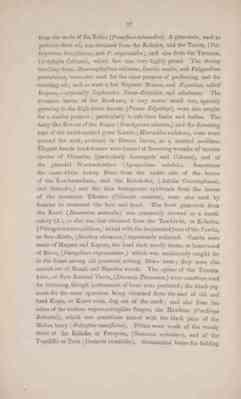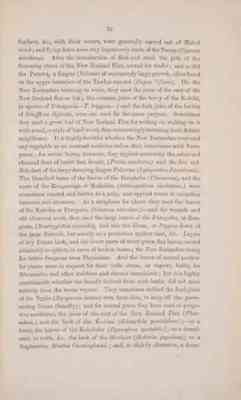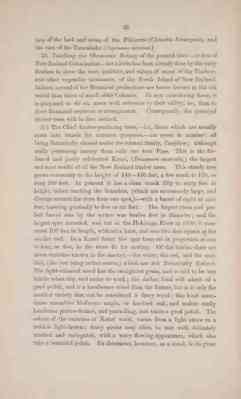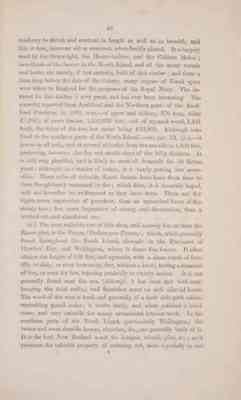Pages
36 times of Toetoe (Arundo conspicua). Baskets, large and small, plain, and highly ornamented, and dyed, for all manner of uses, were woven of the same materials; and sometimes the leaves of the Ti (Cordyline australis,) and of the Nikau Palm (Areca spida,) were also used for the same purposes. Their sitting and sleeping places were strewed with the leaves of the Toetoe, or of Raupo; with the soft fragrant grass Karetu (Hierochloe redolens,) when in season, and sometimes with the leaves of the Papaauma, (Coprosma gradifolia); for visitors of rank, however, the fronds of different tree ferns were used, particularly of the Ponga (Cyathea dealbata). The New Zealanders were often curiously particular as to what plants were used tied around, or under and over, their vegetable food in their cooking ovens in the earth; for instance, the roots of the Tikoraha (Cordyline stricta), were tied separately for baking in bundles of Hangehange (Geniostoma ligustrifolium); for their Kao, or prepared sweet potatoes, they used the leaves of the Parataniwha (Elatostemma rugosum); generally, however, they used the fronds of the larger ferns, Lomaria procera, and Goniopteris pennigera. Fire, by friction, was obtained from several woods; the Kaikomako (Pennantia corymbosa) was, however, the one most prized, and also the Pate (Schefflera digitata); and a trunk stem of the Kohia (Passiflora tetrandra) was often sought to carry fire on a journey, as it has the quality of a slow-burning match. The green leaves and branches of the Kawakawa (Piper excelsum), were gathered and laid in rows in their plantations of Kumara, or sweet potatoes, between the beds, and there slowly burnt, that the insects which injured the growing plant might be destroyed by the disagreeable bitter smoke. The Hue, or gourd, (a species of Cucurbitae), gave useful Calabashes, and vessels of several kinds and sizes, from a gill to three gallons, for many purposes. Sometimes, however, large sections of the great sea-weed, Rimurapa, (D'Urvillea utilis) were inflated and used as Calabashes, called Powha, particularly for holding cooked animal food in its own fat, and for oil. The bark of the Totara was also skilfully made up into near vessels, for holding and carrying of water. (3.) Of plants and vegetable substances used as Ornament, &c., the following are the principal:- For Dyes, the bark of the Hinau, and of the Pokaka (Elaeocarpus dentatus, and Hookerianus), and also of the Makomako, (Aristotelia racemosa), were used for black; and the bark of the Tanekaha, or Toatoa, (Phyllocladus trichomanoides), or red. Oil, for anointing, was expressed from the beaten seeds of the Titoki or Titongi, (Alectryon excelsum), and also
37 from the seeds of the Kohia (Passiflora tetrandra). A gum-resin, used to perfume their oil, was obtained from the Kohuhu, and the Tarata, (Pittosporum tenuifolium, and P. ugenioides), and also from the Taramea, (Aciphylla Colensoi), which last was very highly prized. The strong smelling ferns, Hymenophyllum villosum, Doodia media, and Polypodium pustulatum, were also used for the same purpose of perfuming, and for scenting oil; and so were a few fragrant Mosses, and Hepaticae, called Kopura, - especially Lophocolea Novae-Zelandiae, and allodonta. The aromatic leaves of the Raukawa, a very scarce small tree, sparsely growing in the high dense forests, (Panax Edgerleyi), were also sought for a similar purpose; particularly to rub their limbs and bodies. The daisy like flowers of the Roniu (Brachycome odorata,) and the flowering tops of the sweet-scented grass Karetu (Hierochloe redolens), were worn around the neck, enclosed in fibrous leaves, as a scented necklace. Elegant female head-dresses were formed of flowering wreaths of various species of Clematis, (particularly hexasepala and Colensoi), and of the graceful Waewaekoukou (Lycopodium volubile). Sometimes the snow-white downy fibres from the under side of the leaves of the Kowharawhara, and the Kahakaha, (Astelia Cunninghamii, and Solandri,) and the thin transparent epidermis from the leaves of the mountain Tikumu (Celmisia coriacea), were also used by females to ornament the hair and head. The fresh gum-resin from the Kauri (Dammara australis) was commonly chewed as a masticatory (h.), so also was that obtained from the Tawhiwhi, or Kohuhu, (Pittosporum tenuifolium,) mixed with the inspissated juice of the Puwha, or Sow-thistle, (Sonchus oleraceus,) ingeniously collected. Combs were made of Mapara and Kapara, the hard dark woody tissue, or heart wood of Rimu (Dacrydium cupressinum,) which was assiduously sought for in the forest among old protrate rotting Rimu trees; they were also carved out of Mataii and Manuka woods. The spines of the Tumatakuru, or New Zealand Thorn, (Discaria Toumatou,) were sometime used for tattooing, though instruments of bone were preferred; the black pigment for the same operation being obtained from the soot of old and hard Kapia, or Kauri resin, dug out of the earth; and also from the ashes of the curious vegeto-caterpillar fungus, the Hawhato (Cordiceps Robertsii), which was sometimes mixed with the black juice of the Mahoe berry (Melicytus ramiflorus). Flutes were made of the woody stems of the Kohoho or Poroporo, (Solanum aviculare), and of the Tupakihi or Tutu (Coriaria ruscifolia). Ornamental boxes for holding
38 feathers, &c., with their covers, were generally carved out of Mataii wood; and flying-kites were very ingeniously made of the Totoe (Cyperus ustulatus). After the introduction of flint and steel, the pith of the flowering stems of the New Zealand Flax, served for tinder; and so did the Putawa, a fungus (Boletus) of enormously large growth, often found on the upper branches of the Tawhai-rau-nui (Fagus ?fusca). On the New Zealanders learning to write, they used the juice of the root of the New Zealand flax as ink; the crimson juice of the berry of Kokihi, (a species of Tetragonia - T. trigyna, -) and the dark juice of the berries of Schefflera digitata, were also used for the same purpose. Sometimes they used a green leaf of New Zealand Flax for writing on, etching on it with a nail, or style of hard wood, thus unknowingly imitating their Asiatic neighbours. It is highly doubtful whether the New Zealanders ever used any vegetable as an internal medicine before their intercourse with Europeans; for severe burns, however, they applied outwardly the ashes and charcoal dust of burnt fern fronds, (Pteris esculenta,) and the fine reddish dust of the large decaying fungus Pukurau (Lycoperdon Fontainesii). The blanched bases of the leaves of the Harakeke (Phormium), and the roots of the Rengarenga or Maikaika, (Arthropodium cirrhatum,) were sometimes roasted and beaten to a pulp, and applied warm to unbroken tumours and abscesses. As a cataplasm for ulcers they used the leaves of the Kohoho or Poroporo, (Solanum aviculare,) - and for wounds and old ulcerated sores, they used the large leaves of the Pukapuka, or Rangiora, (Brachyglottis repanda), and also the Hune, or Pappus down of the large Bulrush, but merely as a protection against dust, &c. Layers of dry Totara bark, and the lower parts of stout green flax leaves, served admirably as splints, in cases of broken bones; the New Zealanders being far better Surgeons than Physicians. And the leaves of several particullar plants were in request for their rude steam, or vapour, baths, for Rheumatic, and other stubborn and chronic complaints; but it is highly questionable whether the benefit derived from such baths did not arise entirely from the warm vapour. They sometimes rubbed the fresh juice of the Ngaio (Myoporum laetum) over their skin, to keep off the persecuting Namu (Sandfly); and for several years they have used as purgative medicines, the juice of the root of the New Zealand Flax (Phormium), and the bark of the Kowhai (Edwardsia grandiflora); - as a tonic, the leaves of the Kohekohe (Dysoxylum spectabile); as a demulcent, in colds, &c., the bark of the Houhere (Hoheria populnea); as a diaphoretic, Metha Cunninghamii; and, as slightly alterative, a dococ-
39 tion of the bark and stems of the Pikiarere (Clematis hexasepala), and the root of the Tatarahake (Coprosma acerosa.)
24. Touching the OEconomic Botany of the present time - or aera of New Zealand Colonization - not a little has been already done by the early Settlers to show the uses, qualities, and values of many of the Timbers, and other vegetable substances, of the North Island of New Zealand. Indeed, several of her Botanical productions are better know in the old world than those of much older Colonies. In now considering these, it is purposed to do so, more with reference to their utility, &c., than to their Botanical sequence or arrangement. Consequently, the principal timber trees will be first noticed.
(i.) The Chief timber-producing trees, - i.e., those which are usually sawn into boards for common purposes, - are seven in number; all being Botanically classed under the natural family, Coniferae; although really possessing among them only one true Pine. This is the farfamed and justly celebrated Kauri, (Dammara australis,) the largest and most useful of all the New Zealand timber trees. This stately tree grows commonly to the height of 140-150 feet, a few reach to 170, or even 200 feet. In general it has a clean trunk fifty to sixty feet in height, before reaching the branches (which are enormously large, and diverge around the stem from one spot,) - with a barrel of eight or nine feet, tapering gradually to five or six feet. The largest clean and perfact barrel seen by the writer was twelve feet in diameter; and the largest spar recorded, was cut at the Hokianga River in 1839, it measured 106 feet in length, without a knot, and was two feet square at the smaller end. In a Kauri forest the spar trees are in proportion as one to four, or five, to the trees fit for sawing. Of this timber there are three varieties known in the market, - the white, the red, and the mottled, (the last being rather scarce,) which are not Botanically distinct. The light-coloured wood has the straightest grain, and is said to be less brittle when dry, and easier to work; the darker kind will admit of a good polish, and is a handosmer wood than the former, but it is only the mottled variety that can be considered a fancy wood; this kind sometimes resembles bird's-eye maple, or knotted oak, and makes really handsome picture-frames, and pannelling, and takes a good polish. The colour of the varieties of Kauri wood, varies from a light straw to a reddish light-brown; fancy pieces may often be met with delicately marked and variegated, with a wavy flowing appearance, which also take a beautiful polish. Its detriment, however, as a wood, is its great
40 tendency to shrink and contract in length as well as in breadth, and this it does, however old or seasoned, when freshly planed. It is largely used by the Shipwright, the House-builder, and the Cabinet Maker; two-thirds of the houses in the North Island, and all the many vessels and boats, are mainly, if not entirely, built of this timber; and from a time long before the date of the Colony, many cargoes of Kauri spars were taken to England for the purposes of the Royal Navy. The demand for this timber is very great, and has ever been increasing. The quantity exported from Auckland and the Northern ports of the Auckland Province, in 1863, was, - of spars and rickers, 270 tons, value £1,953; of sawn timber, 1,552,636 fet, and of squared wood, 1,641 loads, the value of the two last items being £16,000. Although confined to the northern parts of the North Island, - see, par. 13, (ii), - it is still very plentiful, and is likely to meet all demands for 50 future years; although, as a matter of course, it is yearly getting less accessible. Many miles of valuable Kauri forests have been from time to time thoughtlessly consumed by fire; which fires, it is sincerely hoped, will not hereafter be so frequent as they have been. There are few sights more impressive of grandeur, than an untoched forest of this stately tree; few more impressive of misery and devastation, than a worked-out and abandoned one!
(ii.) The next valuable tree of this class, and scarcely less so than the Kauri pine, is the Totara (Podocarpus Totara); which, while generally found throughout the North Island, abounds in the Provinces of Hawkes' Bay, and Wellington, where it forms fine forests. It often attains the height of 120 feet, and upwards, with a clean trunk of from fifty to sixty, or even to seventy, feet, without a knot; having a diameter of five, or even six feet, tapering gradually to twenty inches. It is not generally found near the sea, (although it has been met with overhanging the tidal rocks,) and flourishes most on rich alluvial levels. The wood of this tree is hard, and generally of a dark dull pink colour, resembling pencil cedar; it works freely, and when polished is handsome, and very suitable for massy ornamental interior work. In the southern parts of the North Island, (particularly Wellington,) the better and more durable houses, churches, &c., are generally built of it. It is the best New Zealand wood for bridges, wharfs, piles, &c.; as it possesses the valuable property of resisting rot, more especially in wet G
